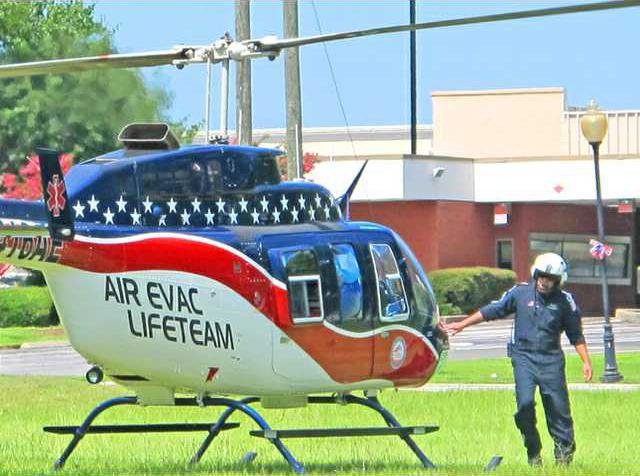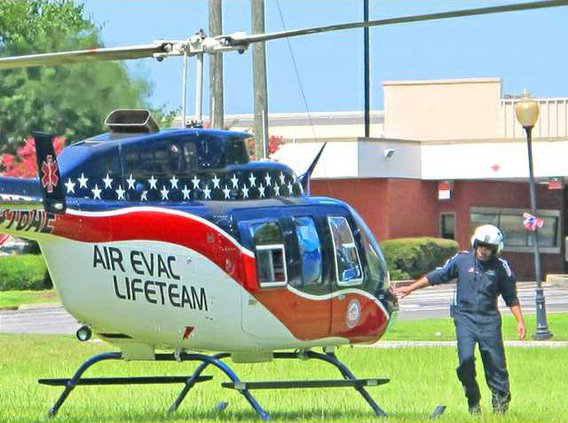Hinesville firefighters assigned to Station 1 got hands-on training this week learning how to help air ambulances land safely. An emergency-helicopter crew from Air Evac Lifeteam’s Jesup base offered firefighters pre-hospital landing-zone classes this week.
“This is our second series of classes with them,” Air Evac Lifeteam Program Director Donald Mixon said. “We did three in May (with Station 22).”
Mixon said Air Evac Lifeteam provides landing-zone training to paid and volunteer fire departments every six months to a year. Firefighters are taught the proper procedures to ensure the safety of an Air Evac crew, the patients they transport and individuals on the ground when an air ambulance lands, while it is on the ground and when it takes off.
A firefighter would be assigned to serve as an incident coordinator, according to Mixon. This individual would be responsible for maintaining direct radio contact with the Air Evac helicopter crew while on scene. They also would describe the landing site location, the patient’s status, weather conditions at the site and provide any other pertinent information that can aid the pilot and crew upon landing.
Firefighters should select a landing-zone site that is a minimum size of 100-feet-by-100-feet, and clear it of any obstructions, such as debris or vehicles, according to Air Evac’s safety-training manual.
“If you don’t have people securing the landing zone, you can have injuries,” Mixon said.
He explained one firefighter would be assigned to serve as a tail-rotor guard to prevent the public from approaching a helicopter while its blades are spinning.
“The tail rotor is invisible when it’s going at top speed,” Mixon said. Firefighters on the ground can also alert an Air Evac crew to power lines, he added.
“Having people on the ground is critical,” Mixon said.
Firefighters also may assist the crew in loading a patient into the air ambulance, at the direction of the Air Evac crew, according to the training manual.
Air Evac’s Jesup base serves a five-county area that includes Wayne, Long, Liberty, McIntosh and Glynn counties, according to Mixon. Other nearby bases are in Waycross, Statesboro and Vidalia.
“We are considered a critical-care transport service because of the level of care we provide,” Mixon said. “Every flight crew has a pilot, a critical-care paramedic and a critical care nurse.”
Mixon describes Air Evac air ambulances as “mobile ICUs.”
Air Evac Lifeteam helicopters are equipped with ventilators, defibrillators and can administer up to six infusions of medications at a time, he said.
“We only come if they (local hospitals or EMS) call us,” Mixon said. “We’re a tool to help them care for the sickest patients.”
The Jesup-based Air Evac Lifeteam has responded to Liberty Regional Medical Center in Hinesville, Wayne Memorial Hospital in Jesup and Southeast Georgia Health System in Brunswick, according to Mixon. These area hospitals might stabilize critically ill or injured patients so an air ambulance crew then can transport them to Memorial Health University Medical Center in Savannah, the only Level 1 trauma center south of Macon, he said.
Mixon stressed that getting critically injured or ill patients to trauma centers the quickest way possible — by air — dramatically can increase survival rates, especially when transporting patients from rural areas to a trauma center that can provide the highest level of care.
“It is 28 nautical miles from Liberty Regional Hospital to Memorial Health University Medical Center in Savannah,” he said. “That would be a 14-minute flight on average. We average 120 nautical miles/hours in the air. It is 22 nautical miles from our base in Jesup to Liberty Regional Medical Center. That would be an 11-minute flight on average. It takes us 7 minutes to lift, on average, once notified we are needed.”
According to the Centers for Disease Control, “injuries are the leading cause of death for children and adults ages 1–44. While most injuries can be treated at a local emergency department, those who are severely injured can lower the risk of death by 25 percent by getting care at a Level I trauma center.”
The CDC defines Level 1 trauma centers as being “capable of providing total care for every aspect of injury — from prevention through rehabilitation.”
Level 1 trauma centers provide “24-hour in-house coverage by general surgeons, and prompt availability of care in specialties such as orthopedic surgery, neurosurgery, anesthesiology, emergency medicine, radiology, internal medicine, plastic surgery, oral and maxillofacial, pediatric and critical care,” according to cdc.gov.
Air Evac EMS Inc., which operates Air Evac Lifeteam, is the largest independently owned and operated membership-supported air medical service in the United States, according to lifeteam.net. In addition to Georgia, the company operates in Alabama, Arkansas, Illinois, Indiana, Iowa, Kentucky, Louisiana, Mississippi, Missouri, Ohio, Oklahoma, Tennessee, Texas and West Virginia.
Firefighters train to assist air ambulance


Sign up for our e-newsletters